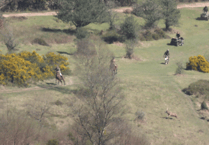A PLANNING inspector’s decision this week to approve a huge solar farm near Williton has caused fury among hundreds of objectors to the scheme.
The inspector, Cullum Parker, allowed an appeal by Elgin Energy to use 100 acres of Wyndham Estate land close to Tropiquaria zoo, Washford Cross.
Mr Parker said far from spoiling the landscape, the proposal ‘would promote the understanding and enjoyment’ of the multiple special qualities of Exmoor National Park and Quantock Hills National Landscape.
He said neither would suffer any direct adverse effect because the development was not actually within either of them.
Somerset Council planning officers had previously supported Elgin’s proposals, but the plans were thrown out by elected councillors last July.
Elgin appealed the decision earlier this year and now Mr Parker has given the go-ahead for ground mounted solar panels to be installed along with battery storage and associated development.
Mr Parker said: “While there is a predominance of what most people would recognise as ‘countryside’ visible within the views, this predominates towards the fringes of the site to the east and west.”
Mr Parker said the landscape was already affected by the tall radio transmitting masts at Washford Cross and the Hinkley Point nuclear power stations a few miles away.
He said: “I acknowledge the various objections and concerns raised by local residents and also by bodies such as the Exmoor National Park Authority.
“Clearly, the insertion of a solar farm into what are currently agricultural fields used for pastoral and arable farming, will change their character and appearance for a period of around 40 years.
“There would be some change in character in comparison to arable farming, with solar and pastoral farming taking place.
“When seen from limited viewpoints within either the national park or AONB (Quantocks), most viewers are likely to feel a heightened sense of ‘specialness’ of those designated landscapes themselves and their importance which, in the main, are devoid of modern developments.”
Mr Parker said he made an unaccompanied visit to the area in April to see it for himself and found most views of the site were obscured by high hedges.





Comments
This article has no comments yet. Be the first to leave a comment.